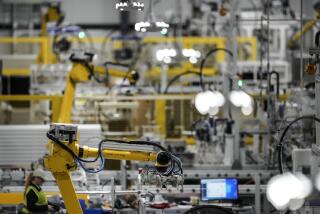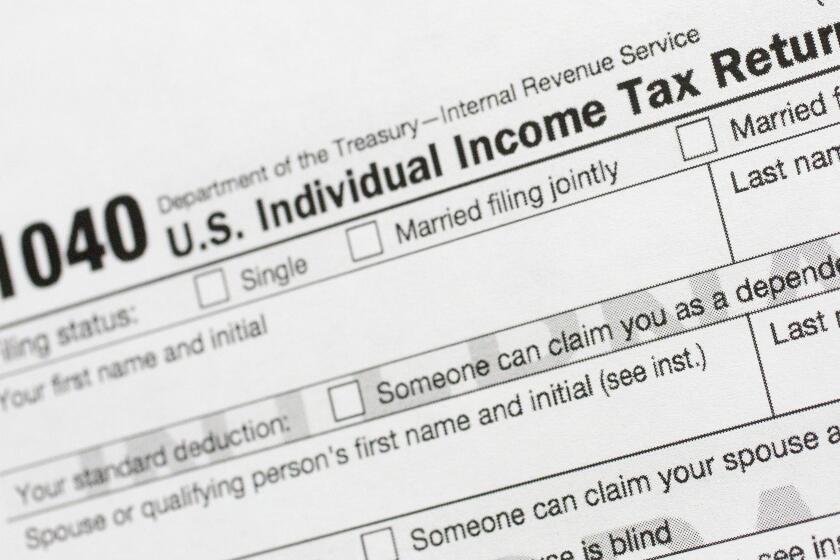Better off in 4 years? Unlikely
WASHINGTON — Transfixed by the daily spectacle of dismal economic news and wild Wall Street swings, few Americans have looked up to see what a wide array of economists say lies beyond the immediate crisis.
And with good reason: The picture isn’t pretty.
The sleek racing machine that was the U.S. economy is unlikely to return any time soon despite the huge repair efforts now underway. Instead, it probably will continue to sputter and threaten to stall for years to come.
The prospects are so gloomy, according to a recent study, that unemployment may be slightly higher by the time President-elect Barack Obama’s first term ends.
The damage done by plunging house and stock prices, the failure of other major economies to be independent sources of growth and hidden weaknesses in America’s past performance have crippled nearly every actor in the nation’s economic drama.
None -- save perhaps the government -- retains the power to push the economy back to speeds it regularly achieved during much of the last generation, economists say.
The result: An economy that once averaged 3% or better annual growth would be lucky to grow 2% a year during the entirety of the new president’s term.
“That is going to feel like stagnation” to most people, said John Lonski, chief economist at Moody’s Investors Service.
“We’re in a post-bubble global recession, and post-bubble recessions are lethal for growth,” Stephen S. Roach, chairman of Morgan Stanley Asia, said from Beijing. “It will be a long time before the world experiences anything more than anemic recovery.”
Obama and his economic aides seem to understand the painful prospects they face.
Obama misses no chance to temper hopes for a quick and complete comeback. A recently released study by Christina Romer, his nominee to chair the Council of Economic Advisors, and Vice President-elect Joe Biden’s chief economist, Jared Bernstein, concluded that, even with an $825-billion stimulus package, the unemployment rate at the end of Obama’s first term would be one-half to one full percentage point above where it was before the start of the recession.
That would mean as many as 1.5 million additional jobless workers. And some independent economists say that number could be much higher.
What most worries analysts is not a cataclysm such as the Great Depression but the sort of economic morass into which Japan fell after its stock and real estate markets burst in the late 1980s and early ‘90s.
Daily life for most Japanese citizens wasn’t terrible. There were few company shutdowns or mass layoffs. Indeed, the Japanese came to call their economic condition the “golden recession,” said Simon Johnson, a senior fellow at the Peterson Institute for International Economics.
The problem was that the country simply didn’t grow -- and that, economists worry, is what could happen in the U.S. and around the world.
“Four years from now, I suspect that we’ll be pretty much where we are today,” Johnson said. The question he predicts people will then ask: “Why can’t we get growth going again?”
Four factors -- like the cylinders of an engine -- power an economy: consumers, investors, the government and a favorable balance of trade with other countries. And for many years, the most important of these has been the American consumer. U.S. households long have accounted for the lion’s share of economic activity not only here but also in much of the rest of the world.
Although U.S. consumers constitute only about 4.5% of the global population, they bought more than $10 trillion worth of goods and services last year. By contrast, said Roach of Morgan Stanley Asia, Chinese and Indian consumers, who together account for 40% of global population, bought only $3 trillion worth.
In the last decade, a new generation of financial engineering -- complex deals involving home equity loans, subprime mortgages and other devices that provided easier access to credit -- seemed to make it safe for Americans to save less and consume more. That further expanded their share of global economic activity and made them even more indispensable here and abroad.
U.S. consumer spending shot up from a little over 73% of the economy to nearly 77% from 2001 to 2007, according to government statistics.
Initially, the expansion was heralded as evidence of economic vitality. But by now, it has become apparent that the growth was largely a debt-driven bubble -- and a double bubble at that, in housing and in personal consumption.
As the elaborate superstructure of easy credit began to pop rivets, consumers found themselves caught dangerously short. They have reacted by drastically cutting back on purchases, particularly those that are discretionary.
Retail sales in the last three months of 2008 plunged 7.7% compared with a year earlier, the government said last week, making it the worst sales quarter in more than 40 years.
At almost any other time, economists would write off such a drop as sharp but short-lived and predict that Americans would return to their spendthrift ways as soon as the economy began to recover. But many veteran forecasters say this time is different.
“Decades of borrowing have finally caught up with consumers; they realize there is no more easy money left,” said Allen Sinai, chief economist of Decision Economics Inc. “This is going to scar this generation of consumers the way the Great Depression did our fathers’ and grandfathers’.”
For the first year of the current crisis, which began in the summer of 2007, there was hope that a replacement for U.S. consumers and a new source of economic strength had been found in the rest of the world’s economies, especially such giant and newly industrializing nations as China and India.
Economists pored over figures suggesting these economies were continuing to boom even as the U.S. tottered on the financial brink. There was much talk about other countries having “decoupled” from America and begun their own, internally fueled expansions.
But by last fall, the hope had faded. The economies of most of the world are either slowing sharply or actually shrinking. Asian powerhouses such as China are doing so because of a bust in exports to the U.S.
Worse yet, much of the Asian boom appears to have sprung from a sort of financial engineering that served as a matched set to that in the U.S. By keeping their currencies undervalued, they kept export prices low and encouraged others -- especially Americans -- to keep buying.
China and other Asian economies “were driven by export bubbles, which, in turn, were a play on the U.S. consumption bubble,” Roach said. With the bubbles on both sides now burst, the U.S. and Asia are dragging each other down, he said.
If renewed consumption isn’t going to revive the U.S. economy, and a growing world able to buy more U.S. exports has vanished, one of the few options for recovery that’s left is business investment.
But investment, especially in high technology, was barely growing even during the boom years of this decade. With the economic crisis, it has plunged.
Lonski, the Moody’s economist, used government statistics to examine business investment in such high-tech items as computer and telecommunications equipment.
What he found was that in most previous cycles, companies quickly resumed investing after the economy moved from bust to boom, pushing computer and telecom orders back above their pre-bust highs. But not in this decade.
Between the last recession in 2001 and the current one, high-tech investment has barely crawled upward. That has left telecom and computer orders still down nearly 50% from their previous highs.
“This shows that technological progress was lagging” during the decade’s good years, Lonski said. It seems unlikely the pattern should improve now that times are bad.
That leaves only government to power the renewed growth. Every Economics 1 textbook introduces the economy with the same simple equation. It reads: consumption + investment + net exports + government spending = gross domestic product or output.
It’s an equation that the new president and his top economic aides know well. With the first three elements negative or contracting quickly, the new administration sees few alternatives but to sharply expand the fourth factor -- government spending.
It’s not a surefire solution. But the hope is that something eventually catches and the nation’s economic engine begins turning over again on its own.
--
More to Read
Inside the business of entertainment
The Wide Shot brings you news, analysis and insights on everything from streaming wars to production — and what it all means for the future.
You may occasionally receive promotional content from the Los Angeles Times.










